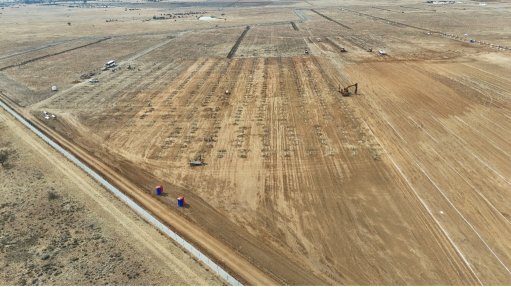Manufacturing sector continues to battle labour, cost headwinds – survey
Business confidence in the manufacturing sector remained shaky during the third quarter of the year and, amid an industry characterised by lingering labour disruptions and elevated labour costs, manufacturers shed a sobering 68 000 jobs over the three months, industry body, the Manufacturing Circle (ManCirc), revealed on Thursday.
The organisation’s manufacturing survey for the third quarter indicated that 60% of firms in the industry considered manufacturing conditions to be “fragile” or “weak”, citing labour instability, an underperforming mining sector, rising input costs, a volatile rand, subdued consumer spending and import competition as the greatest contributors to this volatility.
Pan African Investment and Research Services CEO Dr Iraj Abedian, who analysed the survey data on behalf of ManCirc and compiled the report based thereon, commented that the “tough time” experienced by manufacturers over the period was critically linked to the recent underperformance of the domestic mining environment.
“It’s very difficult, given the close technical relationship between engineering and mining, to separate the performances of each industry. Any disruption in the mining sector will spill over into the manufacturing industries,” he said, referencing the sweeping labour challenges that currently typified the local mining landscape.
A rise in input costs and stagnation in job creation characterised supply conditions in the quarter, while a lack of skills, the inability to fill vacancies owing to financial constraints, the effect of noncompetitive pricing, and plant closures owing to high fixed costs, dragged down the performance of surveyed manufacturers over the three months.
Production costs accelerated from an average of 5.4% year-on-year in the second quarter to 6.7%, while rising costs, coupled with the inability to pass on price increases owing to subdued consumer spending and aggressive competition, suggested that manufacturers either had to scale down production, or find means to lower costs where possible.
“Against this backdrop, it is not surprising to observe that manufacturing employment levels have suffered a severe blow during the quarter according to Statistics South Africa’s Q3 Labour Force Survey, which put the number of jobs shed in the manufacturing sector over the quarter at close to 70 000,” Abedian noted.
On the upside, and for the first time, firms reported that they had benefited from government’s renewable-energy projects, while African demand for South African manufactured goods remained resilient during the quarter.
“While government’s renewable-energy projects are expected to provide further business opportunities, in general, the local procurement programme still only benefits 24% of firms surveyed.
“Consequently, manufacturers do not expect the government’s procurement programme to support growth in their activities,” said Abedian.
Almost half of respondents held the view that the government’s programme was either “unimportant” or “not important at all” to the maintenance of growth in their respective manufacturing concerns.
Meanwhile, 71% of manufacturers sourced 80% or more of their input needs from the local market, which ManCirc considered an “essential” contribution to the growth of the domestic market.
Profitability levels were mixed during the period, with some firms able to “shrug off” the effect of rising input costs, while others struggled to do so.
Results from the survey showed that about 53% of respondents recorded a rise in profits over the quarter, 33% recorded a decline and the remainder experienced no change in profitability.
The reasons advanced for better profitability over the three months included increased volume sales and efficiency, improved absorption of fixed costs, cost containment measures and hedging gains, increased turnover, austerity measures and shareholder support funding.
“There are players that are doing very well in this environment and these are largely highly export-oriented firms that have low import costs and are benefiting from the weaker rand,” Abedian held.
Despite some expected improvements in the coming 12 months, manufacturers believed conditions would remain under pressure, with 47% of respondents expecting a “stable” business environment.
According to the survey, the “increasingly bleak” outlook on manufacturing conditions over the medium term was driven by respondents’ concerns over unstable labour relations, which could cause recurrent and protracted production stoppages, the additional burden of the new broad-based black economic-empowerment Codes of Good Practice, and a failure to compete against cheap products, both locally and globally.
As a result, some 29% of manufacturers expected to decrease their employment complements over the next 12 months and, of that portion, a quarter expected to do so by more than 15%, indicating that mechanisation may now be part of the competitiveness planning of an increasing number of manufacturers.
Comments
Press Office
Announcements
What's On
Subscribe to improve your user experience...
Option 1 (equivalent of R125 a month):
Receive a weekly copy of Creamer Media's Engineering News & Mining Weekly magazine
(print copy for those in South Africa and e-magazine for those outside of South Africa)
Receive daily email newsletters
Access to full search results
Access archive of magazine back copies
Access to Projects in Progress
Access to ONE Research Report of your choice in PDF format
Option 2 (equivalent of R375 a month):
All benefits from Option 1
PLUS
Access to Creamer Media's Research Channel Africa for ALL Research Reports, in PDF format, on various industrial and mining sectors
including Electricity; Water; Energy Transition; Hydrogen; Roads, Rail and Ports; Coal; Gold; Platinum; Battery Metals; etc.
Already a subscriber?
Forgotten your password?
Receive weekly copy of Creamer Media's Engineering News & Mining Weekly magazine (print copy for those in South Africa and e-magazine for those outside of South Africa)
➕
Recieve daily email newsletters
➕
Access to full search results
➕
Access archive of magazine back copies
➕
Access to Projects in Progress
➕
Access to ONE Research Report of your choice in PDF format
RESEARCH CHANNEL AFRICA
R4500 (equivalent of R375 a month)
SUBSCRIBEAll benefits from Option 1
➕
Access to Creamer Media's Research Channel Africa for ALL Research Reports on various industrial and mining sectors, in PDF format, including on:
Electricity
➕
Water
➕
Energy Transition
➕
Hydrogen
➕
Roads, Rail and Ports
➕
Coal
➕
Gold
➕
Platinum
➕
Battery Metals
➕
etc.
Receive all benefits from Option 1 or Option 2 delivered to numerous people at your company
➕
Multiple User names and Passwords for simultaneous log-ins
➕
Intranet integration access to all in your organisation




















